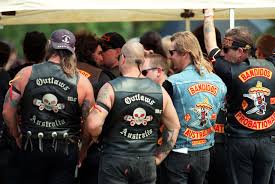Introduction
In recent years, Biker Gang News has dominated global headlines, revealing a world that blends rebellion, loyalty, and crime. From North America to Europe and Australia, outlaw motorcycle clubs — often known as “biker gangs” — have built powerful underground networks.
While most motorcycle enthusiasts ride for passion and freedom, a small fraction belong to groups involved in organized crime, including drug trafficking, weapons smuggling, and territorial disputes.
This article explores the latest Biker Gang News, the origins of these groups, their influence on pop culture, and how modern law enforcement and Future Technology Trends are changing the fight against outlaw biker organizations.
The Origins of Biker Gangs
The roots of biker gangs trace back to the post–World War II era. After returning from combat, many soldiers sought the same adrenaline rush and brotherhood they experienced in the military. Motorcycles became their new symbol of freedom — and rebellion.
The Rise of the Outlaw Image
In the 1940s and 1950s, motorcycle clubs began to emerge across the United States. Most were harmless social groups, but a few gained notoriety for lawlessness.
The infamous “Hollister Riot” in 1947 — later dramatized in the film The Wild One — gave rise to the stereotype of the “outlaw biker.” Afterward, the American Motorcycle Association (AMA) allegedly stated that “99% of bikers are law-abiding citizens” — leaving the remaining 1% to proudly label themselves “1 Percenters.”
These self-proclaimed 1% clubs, such as the Hells Angels, Outlaws, Bandidos, and Mongols, became legendary. Their distinct patches, leather jackets, and rigid codes of loyalty defined a subculture that persists to this day.
Global Presence of Biker Gangs
What began in postwar America soon spread worldwide. Today, Biker Gang News often covers incidents and alliances that span multiple continents.
1. North America
The United States remains home to the most influential biker gangs.
- Hells Angels MC (founded in 1948) is the largest, with chapters across the world.
- Bandidos MC and Outlaws MC rival their power, leading to violent turf wars in states like Texas and Florida.
- In Canada, biker gangs have been linked to organized crime networks, especially during the Quebec Biker War of the 1990s, which claimed over 150 lives.
2. Europe
Biker gangs have a strong foothold across Europe.
- The Hells Angels operate legally registered clubs in Germany, Spain, and the UK but have faced multiple raids for alleged drug and arms trafficking.
- The Bandidos and Satudarah MC, originating from the Netherlands, have expanded rapidly across the continent, often clashing with rivals.
3. Australia
Australia’s biker scene has grown increasingly violent. Groups such as the Comancheros, Mongols, and Rebels MC have been involved in high-profile shootings, extortion, and large-scale drug operations. The Australian government has enacted strict anti-bikie laws, limiting gang gatherings and confiscating club assets.
4. Asia and Latin America
In countries like Thailand and Brazil, biker gangs are merging with local crime syndicates, making law enforcement more complex. Motorcycle culture, once about freedom, has evolved into a symbol of both rebellion and danger.
Recent Biker Gang News and Major Incidents
1. U.S. Biker Shootouts (2023–2024)
Texas and Nevada have seen renewed tensions between rival gangs, leading to violent shootouts at biker rallies. Several arrests were made for illegal firearms and narcotics trafficking.
2. Europe Crackdowns
In 2024, German police launched a major operation against Hells Angels and Bandidos, seizing weapons, luxury vehicles, and over €2 million in cash. Authorities described it as one of the largest anti-gang raids in European history.
3. Australia’s “Bikie Task Forces”
Australian police have intensified efforts against biker gangs, using advanced surveillance and financial tracking to dismantle drug networks. Over 50 arrests were made in a 2025 national operation targeting gang leaders.
These global developments show that Biker Gang News is not just about rebellion — it’s about international organized crime.
Inside the Culture of Biker Gangs
Despite their violent reputation, biker gangs have a structured and deeply loyal culture. Membership is often for life, governed by strict hierarchies and rituals.
1. Membership and Hierarchy
Joining a biker gang is a process. Prospective members, known as “prospects,” must prove loyalty through months or even years of service. Ranks typically include:
- President – Leader of the chapter
- Vice President – Second-in-command
- Sergeant-at-Arms – Enforces club discipline
- Treasurer/Secretary – Manages finances and communications
2. Symbols and Patches
Each club’s “colors” — their distinctive patches — carry immense meaning. The back patch typically displays the club’s name, logo, and location. Unauthorized use or imitation can lead to violence.
3. Brotherhood and Code of Silence
Members treat each other as family. Betrayal or “snitching” is unforgivable. The code of silence remains one of the most defining features of biker culture.
Media and Pop Culture Influence
From Hollywood films to TV series like Sons of Anarchy and Mayans M.C., biker gangs have fascinated audiences for decades. These portrayals often romanticize the lifestyle — emphasizing freedom, rebellion, and loyalty — while downplaying the darker reality of crime and violence.
In music and fashion, the biker aesthetic — leather jackets, tattoos, and loud choppers — remains iconic. Even legitimate motorcycle clubs have adopted this style, blurring the line between outlaw culture and mainstream identity.
However, the glamorization of biker life in entertainment can distort public perception, making it harder to differentiate between hobbyists and criminals.
Law Enforcement and Crackdowns
Police forces worldwide have formed specialized task forces to combat biker-related organized crime. Cooperation between agencies — such as Europol, the FBI, and Interpol — has led to coordinated international operations.
Tactics Include:
- Surveillance and Wiretapping: Tracking communications between chapters.
- Financial Investigations: Targeting money laundering through legitimate businesses.
- Technology Use: Employing digital forensics to analyze encrypted gang communications.
- Asset Seizures: Confiscating motorcycles, properties, and cash linked to illegal activities.
While biker gangs have adapted by using encrypted apps and private social networks, Future Technology Trends in cybersecurity and AI-driven analytics are helping law enforcement stay one step ahead.
Future Technology Trends in the Fight Against Biker Crime
Modern policing increasingly relies on innovation. Emerging Future Technology Trends are transforming how authorities track and disrupt biker gangs:
1. Artificial Intelligence and Predictive Policing
AI systems analyze crime data and communication patterns to predict potential conflicts or smuggling routes between biker gangs.
2. Drone Surveillance
Law enforcement agencies use drones to monitor biker gatherings and transport routes — especially during large-scale rallies.
3. Blockchain and Financial Tracking
Blockchain analysis tools trace cryptocurrency transactions, revealing hidden money flows between gang members.
4. Digital Profiling and Big Data
Advanced databases combine intelligence from different countries, creating real-time maps of biker gang hierarchies and movements.
5. Forensic Cybersecurity
Cyber units now specialize in decrypting gang messages, identifying online recruitment efforts, and dismantling dark web marketplaces used for illegal trade.
Platforms like techbillion7.com highlight how Future Technology Trends play a critical role in ensuring safety in an increasingly digitalized world.
Social Impact of Biker Gangs
The presence of biker gangs has social and economic consequences. While some members participate in charity events or local rides, others contribute to violence and organized crime that destabilize communities.
Public opinion remains divided — admiration for their freedom and brotherhood often clashes with fear of their criminal activities. Governments are under constant pressure to balance civil liberties with strong enforcement.
Conclusion
Biker Gang News reveals more than just stories of crime — it exposes a cultural paradox. These groups embody freedom and loyalty while often operating outside the law.
As technology evolves, law enforcement and digital intelligence are reshaping how biker gangs are tracked, studied, and dismantled. With Future Technology Trends, the balance of power is shifting — from back-alley hideouts to the data-driven battlegrounds of the 21st century.
In the end, the story of biker gangs is both a cautionary tale and a cultural phenomenon — a reminder that rebellion can inspire, but unchecked power can destroy.





